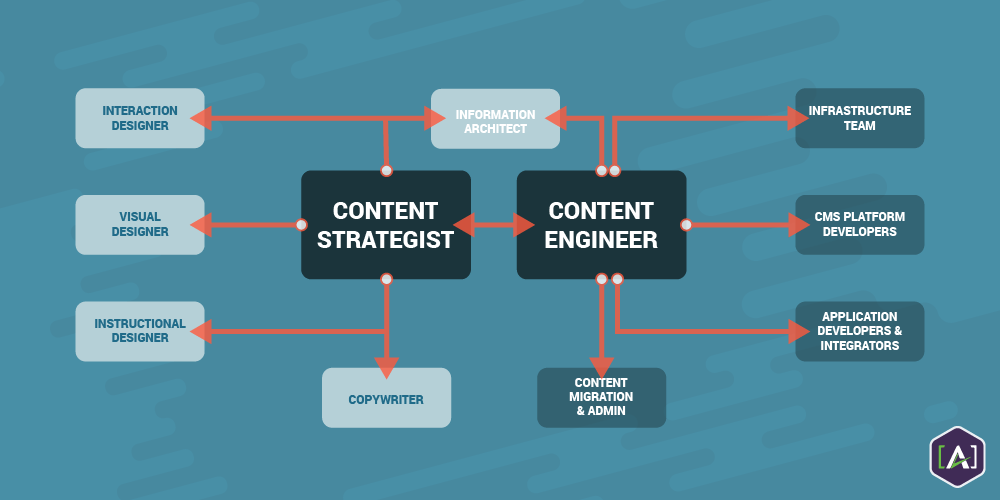Content engineering is now or should be an intrinsic aspect of business content production and workflows. In this article, we will delve into five core reasons why integrating content engineering into your workflow is necessary.
Content engineering links content strategy, information architecture, user experience, design, and development. This discipline enables the shift from static, unstructured content to dynamic, modular, and intelligent content, allowing for personalized user experiences across multiple channels. In today's Customer Experience Management (CEM), content engineering is foundational in creating, delivering, and managing content effectively.
The Five Essential Reasons to Integrate Content Engineering
Reason 1: Eliminating Guesswork in Content Reuse
Content engineering is not a mysterious art but a structured and systematic approach to content creation. It involves creating content models, using reusable components, and implementing content governance policies. These elements work together to streamline content creation. What does all this mean for you? It means less time wasted, cost reduction, and top-notch content, not a mess.
Without a content model, UX designers and CMS developers guess what content elements will be reused, how, and when, often resulting in broken and inconsistent content types.
Specific ways content engineering eliminates guesswork include:
- Identifying reusable components through content models.
- Ensuring content is created in a reusable way via governance policies.
- Automating content reuse through content management systems.
In short, content engineering provides a transparent and efficient process for creating and managing content, resulting in cost and time savings and enhanced content quality.
Reason 2: Empowering Content Authors
By implementing content engineering strategies, content developers can overcome the limitations of static content chunks, create flexible and engaging content, and streamline the authoring process, ultimately enhancing the user experience and content effectiveness.
The Shift Towards Modular Content
Working with static content chunks can be like solving a puzzle with pieces that don't quite fit. These pre-formatted content chunks come with limitations that content developers must navigate.
Picture yourself running an e-commerce store and wanting to personalize product descriptions based on customer preferences. Traditional static content chunks can complicate this process. However, with content engineering, you can simplify creating and updating product descriptions using content models, reusable components, and templates. This saves time and ensures that your product descriptions are reviewed and approved before publishing them on your website.
There's a notable shift towards using modular content instead of static content chunks. Modular content is generated on the fly based on user preferences, context, and real-time events. However, it's important to acknowledge that developing and managing modular content can be more complex than static content chunks.
The most effective approach for content developers is to balance static content chunks and modular content based on their needs. This combines the advantages of structured, consistent static content with modular content's flexibility and personalization capabilities. Content engineering facilitates this balanced approach by equipping content authors with tools and frameworks to streamline the authoring process while maintaining flexibility.
1. Streamlining the Authoring Process
- Content Models: Simplify content creation and ensure consistency and efficiency by defining content types such as product descriptions, images, and specifications.
- Reusable Components: Save time and enhance content quality by developing reusable pieces of content that can be used in various contexts.
- Templates: Speed up content creation and maintain brand consistency by providing pre-defined structures for content.
- Workflows: Automate the authoring process and ensure timely publication by guiding content through different stages, including review and approval.
2. Providing Flexibility
- Modular Content: Empower authors to assemble content from various sources and create custom content experiences by structuring content into small, independent modules.
- API-Driven Content: Easily integrate content with other systems and applications using APIs, making content management and integration accessible.
Reason 3: Unlocking Content Organization
Navigating through a maze of folders in a content library is like looking for a specific sock in an overstuffed drawer. It's time-consuming and frustrating, especially for large organizations. The traditional hierarchical folder structure has limitations, such as difficulty finding content, managing duplicates, and reusing assets effectively.
Content engineering offers a solution to these challenges. By using taxonomies and metadata models, content is structured in a more flexible and user-friendly way. Taxonomies classify content in a detailed and adaptable manner, while metadata models define and organize content based on associated metadata.
Imagine an e-commerce company with a vast product catalog. A content engineer can use a well-designed taxonomy to classify products and subcategories, making it easier for customers to navigate and discover products. For e-commerce managers, a content engineer can use a metadata model to organize multiple product versions, languages, and document types in software documentation, empowering users to find precise information within diverse documentation.
Reason 4: Syndicating Content for the Web
In the digital age, syndicating content across the web is like casting a wider net to reach more people and get better visibility. But it's not just about publishing content on different platforms; it's about integrating schemas and content standards smartly to boost search engine visibility and ensure your content connects with users and algorithms.
In web content, schema is like a tool that outlines the structure and meaning of a webpage's content. It helps search engines and applications understand and process the content. By strategically including schema, you provide extra information to search engines for more informative results in search listings. For instance, it can display star ratings for products or event dates for upcoming events.
Plus, it's about more than just helping search engines. Schema goes beyond that and benefits other apps like social media platforms and content aggregators. They can use schema to understand the content better and present it in the most relevant way to their users.

The Benefits of Schema Integration and Content Standards
- Using schema for content syndication brings multiple advantages to the table:
- Increased Reach and Visibility
- Enhanced User Experience
- Augmented Traffic and Engagement
- Improved SEO
Let's talk about the same e-commerce company that offers a wide range of products. By adhering to content standards and consistent formatting, this company ensures that all product pages are structured uniformly and contain relevant keywords. This enhances the user experience and helps search engines understand the content effectively.
Search engines use schema and content standards to comprehend the product pages as they crawl through the company's website. This results in comprehensive indexing, making the product pages more discoverable for various search queries. Consequently, search engine visibility improves significantly, driving more traffic to the e-commerce website.
Reason 5: Enabling Advanced Content Marketing
Regarding advanced content marketing, content engineering is not just a nice-to-have or something optional. It's essential for effective customer experience management. Content engineering empowers organizations to create, manage, and optimize content models, ensuring content is structured consistently and efficiently.
So, we've already talked about the e-commerce scenario where content engineers come into play, creating content models and reusable components to empower product managers. These components make creating and updating product recommendations for customers visiting the company's website, mobile app, or email campaigns quick and easy. They get personalized product suggestions that enhance their shopping experience. Content engineers analyze user behavior and past purchases to ensure customers get tailored recommendations that boost sales and increase customer satisfaction. By customizing content to individual preferences, content engineering aligns content marketing with effective CEM, resulting in experiences that resonate with customers and meet their unique needs.
Effective Customer Experience Management (CEM) is a key goal for any organization. It's all about delivering personalized content experiences, reaching customers through the right channels, and continuously analyzing and improving.
Here are a few more ways content engineering boosts effective CEM:
- Content Knowledge Bases: Content engineers are the ones who develop and maintain knowledge bases, providing self-service support options for the organization. This helps lighten the load on support teams and enhances the overall user experience.
- Content Governance Policies: Content engineers set policies to keep content consistent, accurate, and up-to-date. This ensures a better customer experience, decreases the chance of errors, and boosts brand credibility.
- Training Customer-Facing Employees: By integrating content engineering into customer experience management efforts, organizations can significantly enhance customer satisfaction, improve the overall customer experience, and drive sustained business growth. It's not just about having good content; it's about creating content tailored to delight customers and ensure the success of your brand.

Implementing Content Engineering in Your Workflow
So, you're convinced that content engineering is the way forward for your organization. Now, how do you get started?
Our knowledgeable team of content engineers at [A] is here to assist you. We specialize in assessing your existing content management process to identify areas where content engineering can make a significant impact on efficiency, effectiveness, and scalability. This assessment will serve as your blueprint for the journey ahead.
[A] will help you develop a well-crafted content engineering strategy that outlines your goals, the tools and technology you'll use, and who can be part of your content engineering team. This could involve hiring new talent or retraining your current staff to fit the content engineering mold.
Now, let's make the big shift - [A] provides the tools and expertise to migrate your content, giving it a fresh look, building innovative models, and crafting reusable content pieces to propel your brand forward.
Automation plays a crucial role in streamlining your content management. Our team will help you set up content engineering workflows that automate tasks like content creation, review, and publishing—regularly monitoring and measuring your content engineering efforts to keep everything running smoothly.
Here are a few bonus tips: start small to avoid overwhelming the whole system, ensure everyone is on board, and remember that content engineering takes time - it's a process, not an overnight solution. Focus on critical areas like content creation, management, delivery, and governance to truly harness the power of
content engineering.
Content Engineering Resources from [A]: